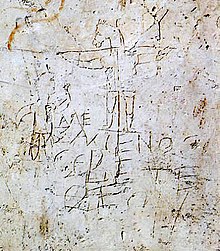The Alexamenos graffito (also known as the graffito blasfemo, or blasphemous graffito)[1]: 393 is a piece of Roman graffito scratched in plaster on the wall of a room near the Palatine Hill in Rome, Italy, which has now been removed and is in the Palatine Museum.[2] Often called the earliest depiction of Jesus, the graffito is difficult to date, but has been estimated to have been made around the year 200 AD.[3] The image seems to show a young man worshipping a crucified, donkey-headed figure. The Greek inscription approximately translates to "Alexamenos worships [his] god,"[4] indicating that the graffito was apparently meant to mock a Christian named Alexamenos.[5]

Content

The image depicts a human-like figure affixed to a cross and possessing the head of a donkey or mule. In the top right of the image is what has been interpreted as either the Greek letter upsilon or a tau cross.[1] To the left of the image is a young man – apparently intended to represent Alexamenos[6] – as a Roman soldier or guard, raising one hand in a gesture possibly suggesting worship.[7][8] The name Alexamenos (and its Latinate variant Alexamenus) is also attested in the instances of Alexamenus of Teos, student of Socrates, and the general,Alexamenus of Aetolia (2nd century BC), possibly composed of the common Greek compound elements of ἀλέξω (alexo, "I defend, help") and μένος (menos, "strength, bravery, power, etc."). Alternatively, it may be derived from Greek ἀλεξάμενος (alexamenos), which is the participle of that same Greek verb. [9] Beneath the cross is a caption written in crude Greek: ΑΛΕ ΞΑΜΕΝΟϹ ϹΕΒΕΤΕ ΘΕΟΝ, ALE XAMENOS SEBETE THEON. ϹΕΒΕΤΕ can be understood as a variant spelling (possibly a phonetic misspelling)[2] of Standard Greek ϹΕΒΕΤΑΙ, which means "worships".[a] The full inscription would then be read as Ἀλεξάμενος σέβεται θεόν, "Alexamenos worships [his] God".[2][10][11] Several other sources suggest "Alexamenos worshiping a god", or similar variants, as the intended translation.[12][13][14][15] In the next chamber, another inscription in a different hand reads ΑΛΕξΑΜΕΝΟϹ FIDELIS (Alexamenos fidelis), Latin for "Alexamenos is faithful" or "Alexamenos the faithful".[16] This may be a retort by an unknown party to the mockery of Alexamenos represented in the graffito.[17][dubious – discuss]
Date
No clear consensus has been reached on when the image was made. Dates ranging from the late 1st century AD to the late 3rd century AD have been suggested,[18] with the beginning of the 3rd century AD thought to be the most likely.[10][17]
Discovery and location
The graffito was discovered in 1857 when a building called the domus Gelotiana was unearthed on the Palatine Hill. The emperor Caligula had acquired the house for the imperial palace, which, after Caligula died, became used as a Paedagogium (boarding school) for imperial page boys. Later, the street on which the house sat was walled off to give support to extensions to the buildings above, and it thus remained sealed for centuries.[19]
Interpretation
The inscription is usually taken to be a mocking depiction of a Christian in the act of worship. At the time, pagans derided Christians for worshipping a man who had been crucified.[20] The donkey's head and crucifixion would both have been considered insulting depictions by contemporary Roman society. Crucifixion continued to be used as an execution method for the worst criminals until its abolition by the emperor Constantine in the 4th century, and the impact of seeing a figure on a cross is comparable to the impact today of portraying a man with a hangman's noose around his neck or seated in an electric chair.[21]
It seems to have been commonly believed at the time that Christians practiced onolatry (donkey-worship). That was based on the misconception that Jews worshipped a god in the form of a donkey, a claim made by Apion (30-20 BC – c. AD 45-48) and denied by Josephus in his work Against Apion.[22]
Origen reports in his treatise Contra Celsum that the pagan philosopher Celsus made the same claim against Christians and Jews.[23]
Tertullian, writing in the late 2nd or early 3rd century, reports that Christians, along with Jews, were accused of worshipping such a deity. He also mentions an apostate Jew who carried around Carthage a caricature of a Christian with ass's ears and hooves, labeled Deus Christianorum ὀνοκοίτης[24] ("The God of the Christians conceived of an ass.").[25]
In the image, Alexamenos is portrayed venerating an image of the crucifix, a detail that Peter Maser believed to represent actual Christian practice, the veneration of icons. This practice, however, was not known to be a part of Christian worship until the 4th or 5th century.[10]


Some scholars have argued the inscription is actually a depiction of the jackal-headed Egyptian god Anubis. For example, in his book on early Christian history published in 1876, Rev. John P. Lundy identifies the inscription as the "Gnostic Anubis."[26] He writes that the inscription depicts the "head of Anubis, or Thoth, the Egyptian Mercury and custodian of the dead".[27] 19th century scholar Charles William King says it is disputed whether it is a caricature of a Christian convert or an adoration of the jackal-headed god Anubis.[28]
Notes
References
Further reading
- Titus Flavius Josephus, Against Apion, II (VII), 2.80
- Norman Walker, The Riddle of the Ass's Head, and the question of a trigram, ZAW 9 (1963), 219–231.
External links
